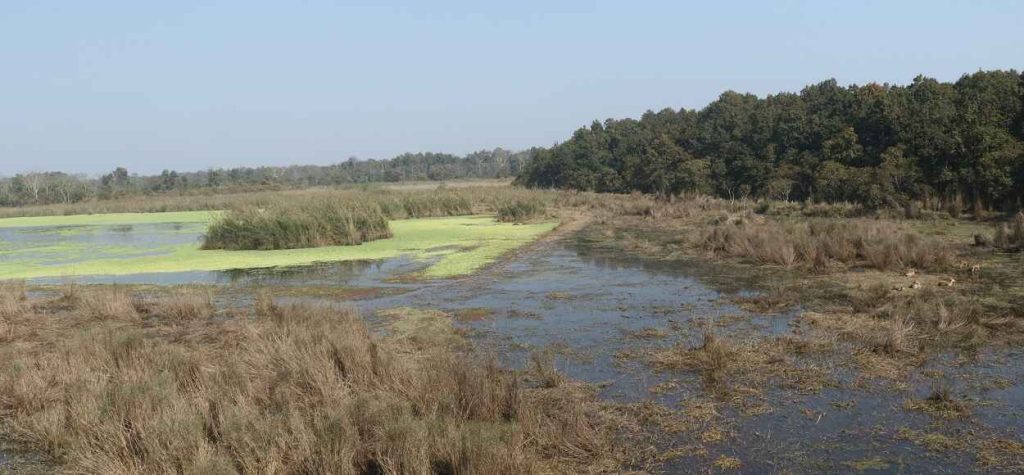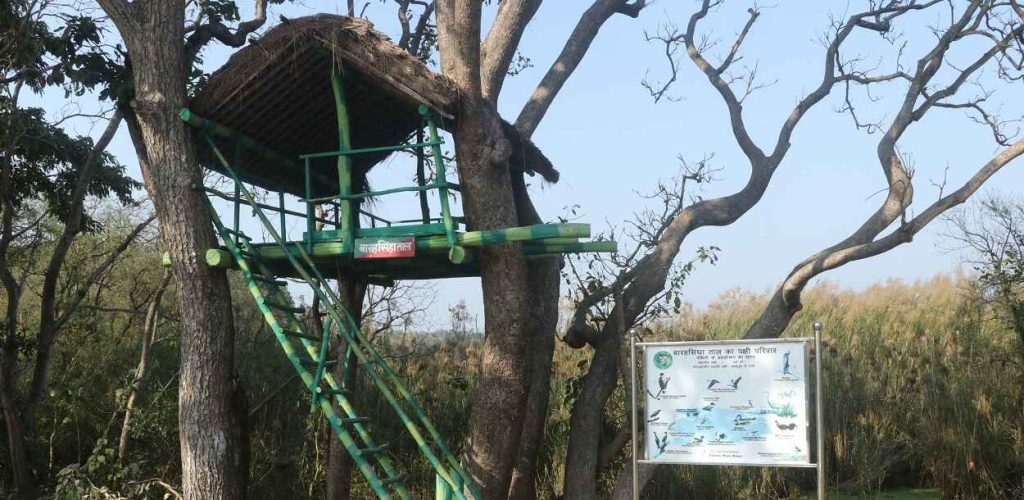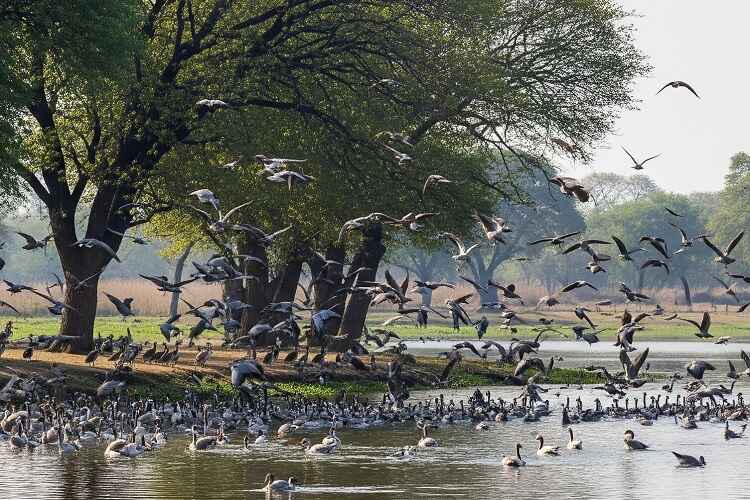Pilibhit Tiger Reserve, located in the Terai region in Uttar Pradesh, is not only a paradise of majestic tigers and wild animals, but also a paradise for avid birdwatchers. Pilibhit Forest area was declared a Project Tiger Reserve in 2008, a place of rich mosaic of habitats, diverse terrains- dense Sal forests and high grasslands, quiet wetlands and river banks. This variety forms a perfect habitat for over 400 species of birds, including both migratory and endangered.
To ornithologists, wildlife photographers, and nature lovers, the reserve is one of the most beautiful birding spots, guaranteeing adventure and tranquility. The list of the finest birdwatching sites within Pilibhit Tiger Reserve and their peculiarities is provided in the report below.
1) Jhand Tal – Wetland Wonders
Jhand Tal is one of the largest freshwater wetlands in the reserve and is one of the most scenic birding areas found in the reserve. A visit to this in the early morning is enchanting, and the birds are soaring with the mists. Jhand Tal is famous for having waterfowl such as Indian Spot-billed Duck, Lesser Whistling Duck, and Purple Heron within it. During the winter, migratory birds like the Northern Pintail, the Eurasian Wigeon, and the Common Teal come here in thousands, and this lake becomes an eye candy.
Look out also among the kingfishers, the jacanas, and the beautiful Indian Pitta, which are always seen darting about the borders of the lake.

2) Chuka Beach – Riverside Birding
Another popular location to visit by the bird watchers is the Chuka Beach, which is close to the Sharda Sagar Dam. Chuka Beach has a riverine ecosystem that draws a diverse birdlife, although it is mostly known to support more jungle safaris and other eco-tourism activities. The tall grasses and the muddy banks serve as nesting and feeding areas to such birds as: Black Stork, Woolly-necked Stork, Indian Cormorant, Grey-headed Fish Eagle.
Chuka is also a winter stopover site of such species as Bar-headed Geese and Greylag Geese. It is also a good place to see owls, drongos, and shrikes within the nearby forested areas.

3) Barasingha Tal – Raptor Country
The name of this water body is derived from the swamp deer (barasingha), which is a common sight at the location; however, it is also a hotspot to see raptors. Having open skies, environs, grasslands, and watersides, this area provides the ideal situation for spotting: Crested serpent eagle, Changeable Hawk-Eagle, Shikra, Osprey.
You could also be fortunate to see Steppe Eagles and Harriers flying over grasslands in search of food in the winter. The stay of birders here is usually long because of bird displays in the air and nesting activities.

4) Mahof Range Forest Trails – Woodland Birding
Mahof Range is renowned for having one of the jungle safari zones, yet its forest pathways are also great for spotting birds that stay in the forest. The pines and the Sal forests provide the dense undergrowth where a wide selection of colored species exist, such as: Indian Paradis, Flycatcher, Oriental Magpie Robin, Black-hooded Oriole, Greater flameback woodpecker.
Birding can be done in the early mornings or late in the afternoon via these trails with or without noise. Mahof also has an excellent chance of hearing and observing the Indian Cuckoo, which has a very characteristic call in the jungle.
5) Mustafabad Area – Grassland & Shrubland Birds
Wetlands, shrub thickets, and open grasslands that can be found in the Mustafabad area are situated within the vicinity of the Chuka Tourism Campus. It is most particularly beneficial to ground-nesting and seed-eating birds such as: Red Avadavat (Munia), Indian Bush Lark, Zitting, Cisticola, Pied Bush Chat.
This is an ideal location to see birds at dawn and dusk, when the level of activity is high. Such winter migrants as Bluethroat and Siberian Stonechat are regularly observed here.
6) Canal & Dam Sides – Waterbirds and Waders
The Pilibhit dam embankments and canals, especially near the Bifurcation Point and Siphon Canal, are a good site to watch waders and waterbirds. The low banks with quiet water attract such birds as the Common Sandpiper, Black-winged Stilt, Red-wattled Lapwing, and Little Egret.
It is also a suitable place to observe darters, plovers, and snipes in action, particularly in the season of migration, which is in the months of November to February.

Tips to Birdwatchers Pilibhit Tiger Reserve
Idealistic time to visit: November to March is the best time since there are migratory birds and good weather conditions.
Time of the day: Typically, the birds are most active in the morning (6:00-9:00 AM) and around sunset (4:00-6:00 PM).
You must carry Binoculars and A zoom camera to explore these Best Birding Points Inside Pilibhit Tiger Reserve & Chuka Beach.
Bird Guidebook
Local Guides: If you are bird watching, visit the forests that have guides who are trained in the identification of birds. They are conversant with bird calls and may assist in the location of hidden species.
Silent Observation: We should be patient and be silent. Birds also act more in peaceful environments.
Why Pilibhit is Special for Birding?
Contrary to most of the tiger reserves whose aim is purely big cat tourism, the conservation plan of Pilibhit involves bird conservation, conservation of wetlands, and eco-tourism for the local people. The border of the Indo-Nepal being close to the reserve makes the area also a significant migration route. It is made more important by hosting species that are listed on the IUCN Red List, such as the White-rumped Vulture, Lesser Adjutant Stork, and the Sarus Crane.
Final Thoughts
Whether you are an expert ornithologist or a nature lover who takes an occasional stroll, Pilibhit Tiger Reserve is as good as it can offer you in North India. The park comprises forests, wetlands, grasslands, and rivers, thus being an untapped bird guide to discover. Bring your camera, binoculars, and your wonderment because you just never know what unique feathered visitor will fly your way!


 How To Reach At PTR
How To Reach At PTR